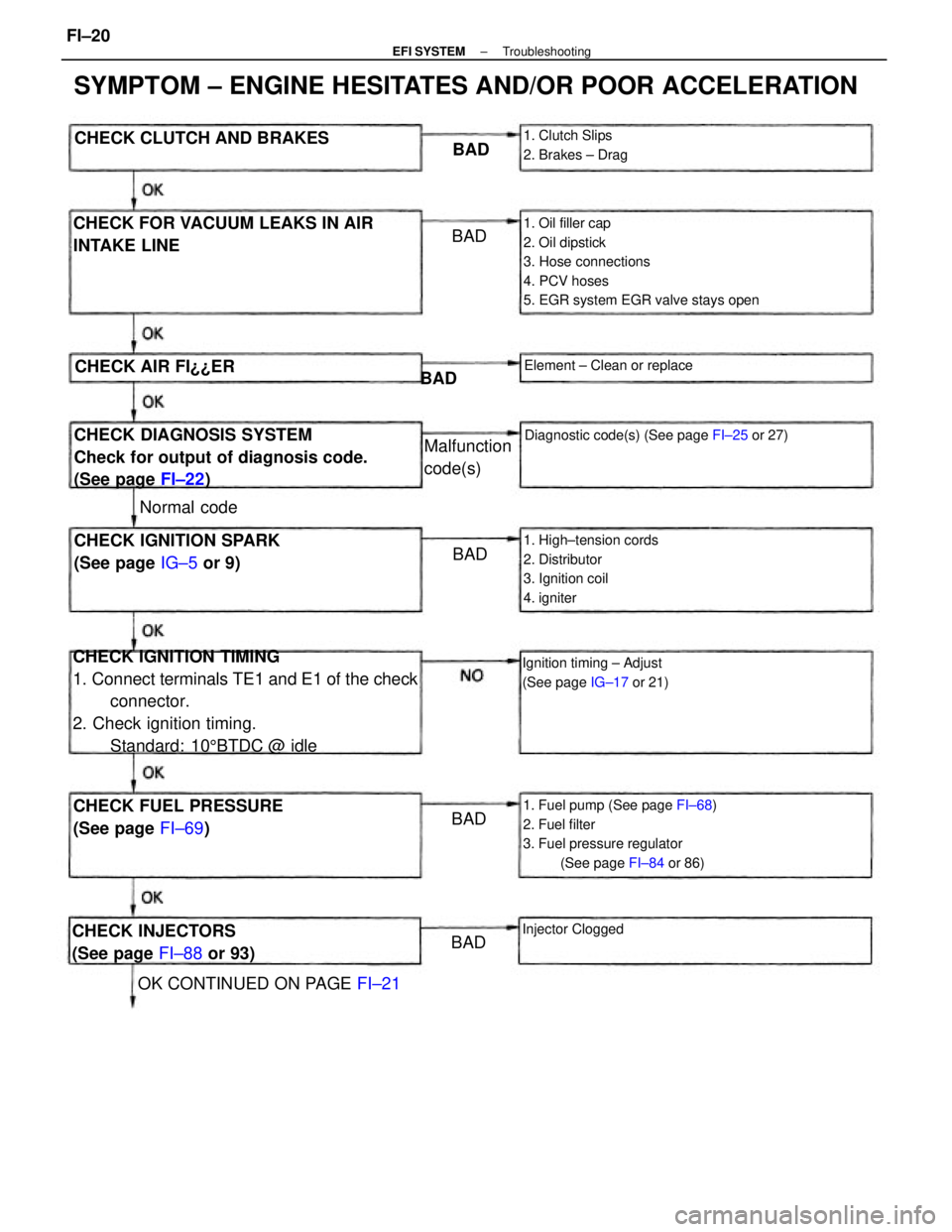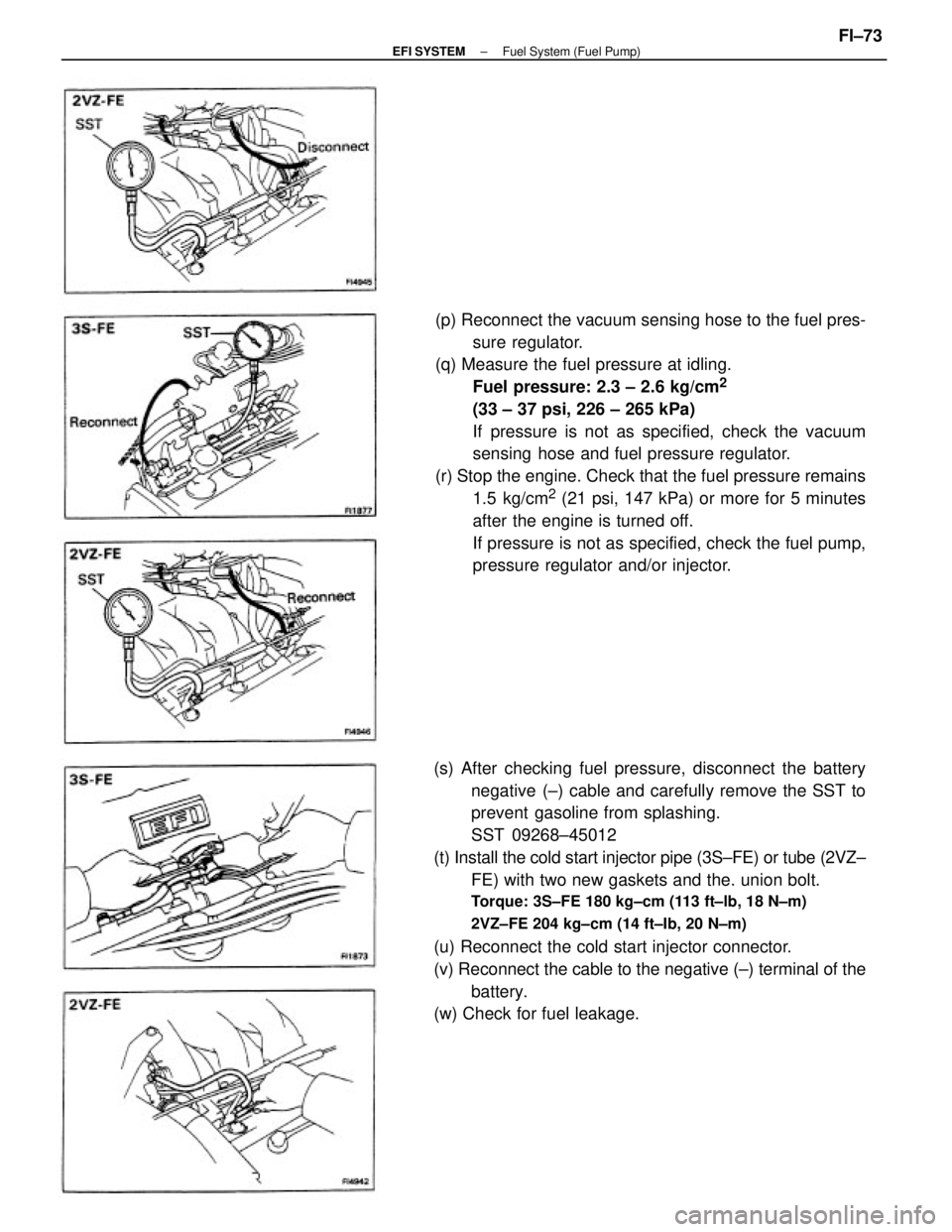Page 1034 of 2389

CHECK IGNITION TIMING
1. Connect terminals TE1 and E1 of the check
connector.
2. Check ignition timing.
Standard: 105BTDC @ idle
1. Oil filler cap
2. Oil dipstick
3. Hose connections
4. PCV hoses
5. EGR system EGR valve stays open
SYMPTOM ± ENGINE HESITATES AND/OR POOR ACCELERATION
1. Fuel pump (See page FI±68)
2. Fuel filter
3. Fuel pressure regulator
(See page FI±84 or 86)
CHECK DIAGNOSIS SYSTEM
Check for output of diagnosis code.
(See page FI±22) CHECK FOR VACUUM LEAKS IN AIR
INTAKE LINE
1. High±tension cords
2. Distributor
3. Ignition coil
4. igniterCHECK IGNITION SPARK
(See page IG±5 or 9)
CHECK FUEL PRESSURE
(See page FI±69)
Diagnostic code(s) (See page FI±25 or 27)
Ignition timing ± Adjust
(See page IG±17 or 21)
CHECK INJECTORS
(See page FI±88 or 93)
OK CONTINUED ON PAGE FI±21 CHECK CLUTCH AND BRAKES
1. Clutch Slips
2. Brakes ± Drag
Element ± Clean or replace
Malfunction
code(s)
Injector Clogged
CHECK AIR FI¿¿ER
Normal codeBAD
BADBAD
BADBAD BAD
± EFI SYSTEMTroubleshootingFI±20
Page 1045 of 2389
FUEL SYSTEM
Fuel Pump
± EFI SYSTEMFuel System (Fuel Pump)FI±68
Page 1046 of 2389
± EFI SYSTEMFuel System (Fuel Pump)FI±69
Page 1047 of 2389
ON±VEHICLE INSPECTION
1. CHECK FUEL PUMP OPERATION
(a) Turn the ignition switch ON.
NOTICE: Do not start the engine.
(b) Using SST, connect terminals +B and FP of the check con-
nector.
SST 09843±18020
(e) Turn the ignition switch OFF.
If there is no pressure, check the following
parts:
wFusible links
wFuses (ER 15 A, IGN 7.5 A)
wER main relay
wFuel pump
wECU
wWiring connections (e) Check that there is pressure in the hose from the fuel
filter.
HINT: At this time, you will hear fuel return noise.
(d) Remove SST.
SST 09843±18020
± EFI SYSTEMFuel System (Fuel Pump)FI±70
Page 1048 of 2389
(f) Install SST (pressure gauge) to the delivery pipe (3S±
FE) or LH delivery pipe (2VZ±FE) with new two gas-
kets and the union bolt.
SST 09268±45012
Torque: 3S±FE 180 kg±cm (13 ft±Ib, 18 N±m)
2VZ±FE 200 kg±cm (14 ft±lb, 20 N ±m)
(g) Wipe off any splattered gasoline.
(h) Reconnect the battery negative H cable. (c) Disconnect the cold start injector connector.
(d) Put a suitable container or shop towel under the cold
start injector pipe (3S±FE) or tube (2VZ±FE).
(e) Remove the union bolt and two gaskets, and discon-
nect the cold start injector tube from the delivery pipe
(3S±FE) or LH delivery pipe (2VZ±FE).
HINT: Slowly loosen the union bolt. 2. CHECK FUEL PRESSURE
(a) Check the battery voltage is above 12 volts.
(b) Disconnect the cable from the negative (±) terminal of the
battery.
± EFI SYSTEMFuel System (Fuel Pump)FI±71
Page 1049 of 2389
(j) Turn the ignition switch ON.
(k) Measure the fuel pressure.
Fuel pressure: 2.7 ± 3.1 kg/cm
2
(38 ± 44 pst, 265 ± 304 kPa)
If pressure is high, replace the fuel pressure regulator.
If pressure is low, check the following parts:
wFuel hoses and connection
wFuel pump
wFuel filter
wFuel pressure regulator
(m) Start the engine. .
(n) Disconnect the vacuum sensing hose from the fuel
pressure regulator, and plug the hose end.
(o) Measure the fuel pressure at idling.
Fuel pressure: 2.7 ± 3.1 kg/cm
2
(38 ± 44 psi, 265 ± 304 kPa) (i) Using SST, connect terminals +B and FP of the check
connector.
SST 09843±18020
(l) Remove SST.
SST 09843±18020
± EFI SYSTEMFuel System (Fuel PumpFI±72
Page 1050 of 2389

(s) After checking fuel pressure, disconnect the battery
negative (±) cable and carefully remove the SST to
prevent gasoline from splashing.
SST 09268±45012
(t) Install the cold start injector pipe (3S±FE) or tube (2VZ±
FE) with two new gaskets and the. union bolt.
Torque: 3S±FE 180 kg±cm (113 ft±lb, 18 N±m)
2VZ±FE 204 kg±cm (14 ft±Ib, 20 N±m)
(u) Reconnect the cold start injector connector.
(v) Reconnect the cable to the negative (±) terminal of the
battery.
(w) Check for fuel leakage.(p) Reconnect the vacuum sensing hose to the fuel pres-
sure regulator.
(q) Measure the fuel pressure at idling.
Fuel pressure: 2.3 ± 2.6 kg/cm
2
(33 ± 37 psi, 226 ± 265 kPa)
If pressure is not as specified, check the vacuum
sensing hose and fuel pressure regulator.
(r) Stop the engine. Check that the fuel pressure remains
1.5 kg/cm
2 (21 psi, 147 kPa) or more for 5 minutes
after the engine is turned off.
If pressure is not as specified, check the fuel pump,
pressure regulator and/or injector.
± EFI SYSTEMFuel System (Fuel Pump)FI±73
Page 1051 of 2389
REMOVAL OF FUEL PUMP
CAUTION: Do not smoke or work near an open flame when
working the fuel pump.
1. DISCONNECT CABLE FROM NEGATIVE TERMINAL
OF BATTERY
2. REMOVE FUEL TANK
4. REMOVE FUEL PUMP FROM FUEL PUMP BRACKET
(a) Pull off the lower side of the fuel pump from the bracket.
(b) Remove the two nuts, and disconnect the wires from the fuel
pump.
(c) Disconnect the fuel hose from the fuel pump.3. REMOVE FUEL PUMP BRACKET FROM FUEL TANK
(a) Remove the bolt of the bracket.
(b) Remove the seven screws, pull out the pump bracket.
COMPONENTS (2WD)
± EFI SYSTEMFuel System (Fuel PumpFI±74